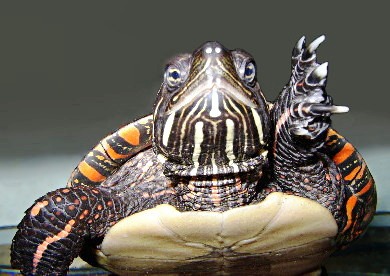- Series:Animals, Transcript English
Job 5:8-9
“I would seek unto God, and unto God would I commit my cause: which doeth great things and unsearchable; marvellous things without number…”
The painted turtle is found farther north than any other turtle in North America. During their first year of life, painted turtles survive temperatures as cold as 18 degrees Fahrenheit.
After mid-June, painted turtles begin to lay their eggs. Each nest holds from seven to nine eggs. Some females will make two nests. The eggs are buried, safely out of sight of predators, and the  mother turtle returns to her normal habitat. The young hatch in ten or eleven weeks. However, they remain buried in the ground, and therefore safe from predators, all winter. The problem is that turtles freeze solid at the temperatures found at nest depth in the winter. When living cells freeze, the long, sharp ice crystals that form in them puncture the cell membrane, killing the cell.
mother turtle returns to her normal habitat. The young hatch in ten or eleven weeks. However, they remain buried in the ground, and therefore safe from predators, all winter. The problem is that turtles freeze solid at the temperatures found at nest depth in the winter. When living cells freeze, the long, sharp ice crystals that form in them puncture the cell membrane, killing the cell.
As the baby turtles freeze, even the heart and brain eventually freeze. There is no breathing and no heartbeat. Only a tiny bit of electrical activity in the frozen brain reveals that life remains in the body. Why don’t ice crystals rupture the cells? The young turtle’s liver makes special proteins that are circulated to every cell in the body. These proteins ensure the formation of very small ice crystals that cannot become large enough to puncture delicate cell walls.
Only God could have invented such a unique method of protecting tiny painted turtles. Even scientists marvel at this.
Prayer:
Father in heaven, truly Your wisdom and power know no limit. I ask that You would help me to realize how Your wisdom and power are most clearly revealed in Scripture so that I may return to the Bible on a regular basis to marvel at Your works and glorify You. In Jesus’ Name. Amen.
Notes:
Janet M. Storey and Kenneth B. Storey. “Out Cold.” Natural History. January, 1992, pp. 23-25.
